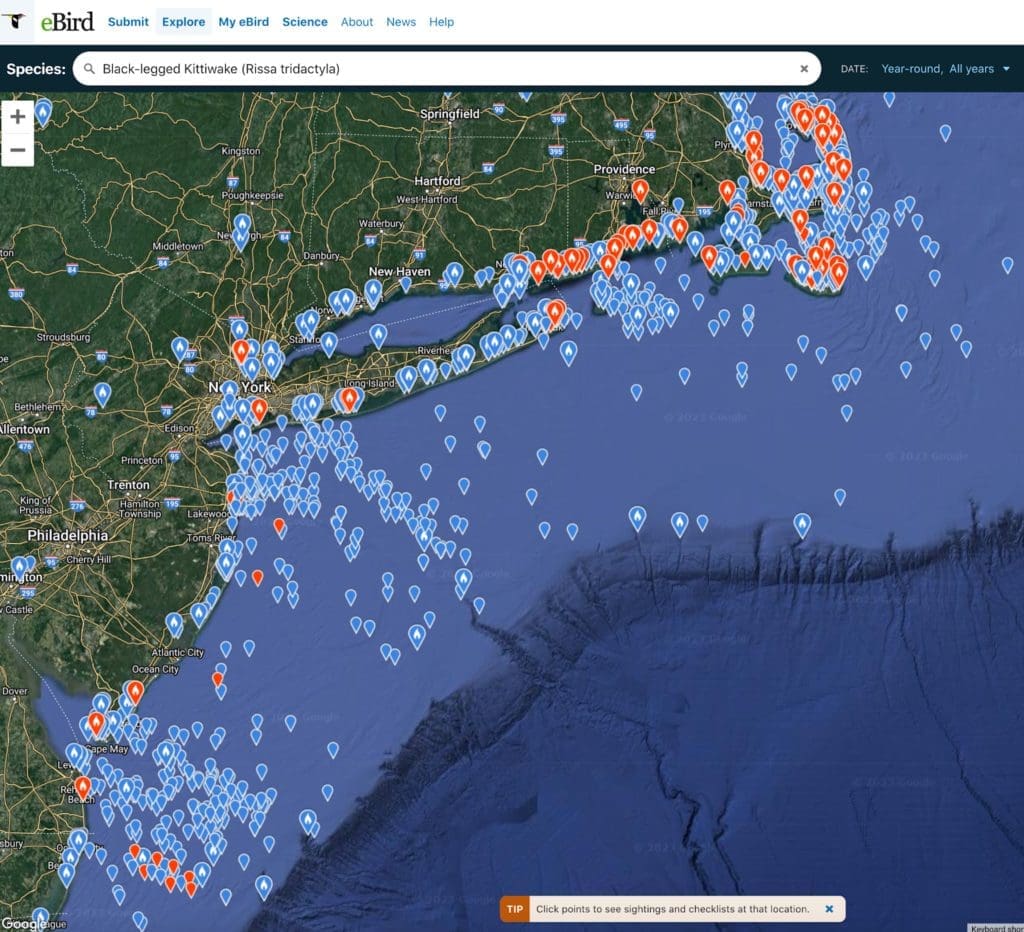Black-legged Kittiwake
Russ Smiley found and photographed this bird on December 19, 2022 off Stonington, CT, and reported it on eBird:
https://ebird.org/checklist/S124246478
STATE YEAR LIST for Connecticut for 2022
By the end of the month of December 2022, Connecticut had recorded 332 species on eBird. Only one new species was added on eBird during December, Black-legged Kittiwake. (See the image below, which is an eBird SYL list sorted by date.) The Kittiwake was the 332nd species added, reported to eBird on December 19, 2022 by Russ Smiley. Because it was the only new species on eBird for the month of December, it was chosen as the Bird of the Month for December.
ARCC Update
The stats on Black-legged Kittiwake for Connecticut from Phil Rusch:
There are 28 Accepted Records, 1 not accepted record, 1 pending: report received, 1 pending: report expected and 31 not reviewed. That’s a total of 64 in the ARCC database.
eBird Maps for the Kittwake
By design, eBird maps use blue and red pins/icons to display the locations of birds reported. The red pins indicate reports in the most recent thirty days, and after that time, the red pins change color to become blue pins. The red pin(s) in the several eBird maps below show the Black-legged Kittiwakes reported in CT this month (“recently”, i.e., during this 30 day period: December 1 through December 31, 2022).

Note that these kittiwakes are regularly seen in winter on the ocean off the coast of Rhode Island and Massachusetts, but uncommonly in Long Island Sound.
These eBird maps were taken from the internet as of January 1, 2023 at 9am.

REFERENCES:
Wikipedia: Black-legged Kittiwake:
https://en.wikipedia.org/wiki/Kittiwake
https://en.wikipedia.org/wiki/Black-legged_kittiwake
Range map for Black-legged Kittiwake:
eBird article on Black-legged Kittiwake::
https://ebird.org/species/bklkit/
Range map of eBird reports for this species:
Audubon Guide to North American Birds:
https://www.audubon.org/field-guide/bird/black-legged-kittiwake
Birds Of The World link, regarding diet of this species:
https://birdsoftheworld.org/bow/species/bklkit/cur/introduction
Including this about their diet,
https://birdsoftheworld.org/bow/species/bklkit/cur/foodhabits
Diet
Major Food Items:
More than 20 fish species identified in food samples collected from 17 locations in Alaska (Figure 5, Table 2); 3 species and 2 families of overwhelming importance—Pacific sand lance, capelin, Pacific herring, gadids (especially walleye pollock, Arctic and saffron cod), and lanterfishes (Myctophidae) (Table 2). Main invertebrate prey include euphausiids (Thysanoessa spinifera, T. inermis, T. raschii, and Euphausia pacifica), the amphipods Paracallisoma alberti and several Parathemisto species, plus various squids and polychaetes unidentified to species. Benthic amphipods (Amplesica, Byblis, Protomedia, Anonyx, and Photis) taken comensally through association with feeding gray whales (Table 2; Grebmeier and Harrison 1992).
Overwintering birds in Monterey Bay, California, consume squid (Loligo opalescens), anchovy (Engraulis mordax), and euphausiids (Thysanoessa spinifera; Briggs et al. 1987b). No information on food of wintering kittiwakes on east coast.
Nestling diet may differ significantly between breeding colonies according to location Frederiksen et al. 2004: in British Isles, whereas sand eels seem especially important at North Sea colonies, clupeids, especially European sprats (Sprattus sprattus) were predominant food at two Irish colonies during early nestling period Chivers et al. 2012. Recent declines in sandeels in NE Atlantic and North Sea have been accompanied by increases there in snake pipefish (Entelurus aequoreus) since about 2003, and the latter have been taken in quantity by kittiwakes and other seabirds, and fed to their nestlings; these rigid fish are hard or impossible to swallow and are in any case of much lower nutritional value than lipid-rich fish species typically consumed. Harris et al. 2008.
Kittiwakes are known to rarely takes bird eggs.
Crossley ID Guides online:
Forms large, spectacular colonies on rocky cliff faces. Pelagic in winter, sometimes within sight of land, particularly in bad weather or where there is plentiful food. ID: An attractive, dainty, clean and well-proportioned gull. Medium-gray upperparts. Short black legs and yellow bill. Buoyant but powerful flyer with long, slim body and wings. Wings often held straight, but sometimes elbow pushed forward creating ‘W’ along leading edge of wing. Stiff shallow wingbeats. Easy to overlook as RBGU, but slimmer, slightly darker with distinctive squared-off black wing-tip and different flight style. Ad br: white head. Nonbr: gray spot to rear of ear coverts. 2nd-year: as adult but some have more extensive black in wing. Juv/1st yr: bold ‘W’ pattern on upperparts. Some have dark ear spot and collar, others all white as adult. Black tail band. Black bill becomes yellow in spring/summer.
Quoted from Crossley
CREDITS / CO-AUTHORS:
This report is a product of the COA Seasonality Project, a team consisting of A.Dasinger, C.Ehlinger, R.Gedney, D.Jernigan, C.Repasz, and co-chaired by M.Bull and T.Robben (https://www.ctbirding.org/about/coa-board-of-directors/ ). It is advised by C.Wood, C.Imbergamo and ARCC: specifically by F.Mantlik, F.Gallo, P.Rusch, G.Hanisek (https://www.ctbirding.org/arcc/committee-members/ ).

